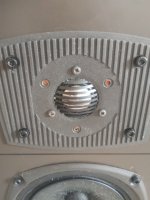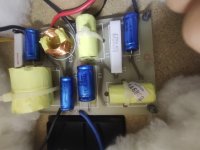@Galu
Woosh that was a Saturday well spent. With a drill and a file I managed to get the magnet and dome attached to the DL10 face plate and utilised the DL10 dome protector grill bit
It sounds all okay but one tweeter has distinctly more brightness.
I'm going to swop them round to see if it's the tweeter or the crossover.
I have also noticed that quite a bit of the bass enters the upper cabinet (internal) so will need to see if there is an ideal wadding positioning.
They are quite "Middly" speakers and if there's too much instrumentation they get a little confused.
All in all they are assembled though I just need to address these two issues.
Again I really appreciate your help very valued.🙏
I have a step by step with pics to put up in case anyone else wants to doctor other Celestion tweeters in the DL range. Is there a specific forum for guides? Cheers 👍
Woosh that was a Saturday well spent. With a drill and a file I managed to get the magnet and dome attached to the DL10 face plate and utilised the DL10 dome protector grill bit
It sounds all okay but one tweeter has distinctly more brightness.
I'm going to swop them round to see if it's the tweeter or the crossover.
I have also noticed that quite a bit of the bass enters the upper cabinet (internal) so will need to see if there is an ideal wadding positioning.
They are quite "Middly" speakers and if there's too much instrumentation they get a little confused.
All in all they are assembled though I just need to address these two issues.
Again I really appreciate your help very valued.🙏
I have a step by step with pics to put up in case anyone else wants to doctor other Celestion tweeters in the DL range. Is there a specific forum for guides? Cheers 👍
Attachments
Good stuff! I'd be tempted to plug those three empty holes by some means or another.
I await the result of swapping the replacement tweeters between enclosures.
I'm not sure what you mean by "I have also noticed that quite a bit of the bass enters the upper cabinet (internal)".
I read this is a rear ported design with separate midrange enclosure and full height figure of eight internal bracing. How is the wadding currently arranged?
There isn't a specific forum section for guides. "Multi-Way" would be the most appropriate location I reckon.
I await the result of swapping the replacement tweeters between enclosures.
I'm not sure what you mean by "I have also noticed that quite a bit of the bass enters the upper cabinet (internal)".
I read this is a rear ported design with separate midrange enclosure and full height figure of eight internal bracing. How is the wadding currently arranged?
There isn't a specific forum section for guides. "Multi-Way" would be the most appropriate location I reckon.
It's a tweeter issue. I swopped them round and the lower level followed the tweeter. I'll just live with it............Or maybe try changing the polarity but I don't think that would make a noticeable difference.
The wadding is very random hence looking for a reasonable starting point. It's been messed about with.
On the lower part of cabinet it has wool felt on sides with a loose poly fibre and upper parts have just loose poly fibre.
Looks like it's all just been chucked in TBH.
The wadding is very random hence looking for a reasonable starting point. It's been messed about with.
On the lower part of cabinet it has wool felt on sides with a loose poly fibre and upper parts have just loose poly fibre.
Looks like it's all just been chucked in TBH.
Polarity change won't do it. The only possibility I can see is to attenuate the loud tweeter to match the quiet one.
I read that the original absorbent material was open cell foam. In a ported enclosure this would normally be attached to the inner walls.
If it was originally a bulk foam filling, it would have been arranged so as not to obstruct the air flow between the bass driver and the port.
I read that the original absorbent material was open cell foam. In a ported enclosure this would normally be attached to the inner walls.
If it was originally a bulk foam filling, it would have been arranged so as not to obstruct the air flow between the bass driver and the port.
You could buy one of these: https://willys-hifi.com/products/l-pad-attenuator-15w-8-ohm-wirewound-volume-control
Wire it to the louder tweeter to adjust its volume accordingly. You can simply hide the control inside the enclosure afterwards.
Here's how to connect it:

Wire it to the louder tweeter to adjust its volume accordingly. You can simply hide the control inside the enclosure afterwards.
Here's how to connect it:
@GaluGood stuff! I'd be tempted to plug those three empty holes by some means or another.
I await the result of swapping the replacement tweeters between enclosures.
I'm not sure what you mean by "I have also noticed that quite a bit of the bass enters the upper cabinet (internal)".
I read this is a rear ported design with separate midrange enclosure and full height figure of eight internal bracing. How is the wadding currently arranged?
There isn't a specific forum section for guides. "Multi-Way" would be the most appropriate location I reckon.
The saga continues. the issue with one of the DL8 tweeters was that the coil was broken causing an intermitent connection. So Im now on the hunt either for a suitable coil/dome for the DL8 magnet which is 25mm (1 inch) and is Alumimium or the DL10 magnet which is 32mm (1.25inch). Research shows the DL10 tweeter was also used in the Celestion Ditton 88. Anyway they are like Hens teeth and not sure the coils on the US and China Ebay will be of good quality.
You're not having much luck with those DL8s after spending good money on them!
Can you actually observe that break in the voice coil wire?
Another (risky) option is to employ a modern budget tweeter whose specifications are close to those of the DL10s.
Can you actually observe that break in the voice coil wire?
Another (risky) option is to employ a modern budget tweeter whose specifications are close to those of the DL10s.
I'd be inclined to take a risk on a couple of these: https://willys-hifi.com/collections/dome-tweeters/products/monacor-dt-100-tweeter
The small faceplates of the tweeters would necessitate the use of adapter plates.
All I can guarantee is that they will tweet in your DL10 speakers, which is better than no tweet at all!
The small faceplates of the tweeters would necessitate the use of adapter plates.
All I can guarantee is that they will tweet in your DL10 speakers, which is better than no tweet at all!

There are a lot of small Neodym tweeter, that you could simply fix with some hot glue on the inside of the face plates.
Anyway, without knowing what SPL the origional tweeter had, Ohms etc. this is not going to work out as something HIFI.
Another thing is the age of the crossover. If there are electrolytic capacitors in it, these will not work well any more. They age and develop all kinds of problems, like to high or to low capacity, high distortin etc. They are cheap to replace, so testing them is useless and some problems don't show on a meter.
Also, they may not filter the tweeter as supposed, leading to them burning trough.
An extremely popular way of killing them is to activate loudness and then give some extra boost to the high frequency. Often because they seem to sound dull at the top end. A very common practice for destroying older speakers.
If you would pull the crossover from one of the speakers and do some good pictures, the knowing people here can tell you what to do to fix your speaker and what replacement tweeter may work.
Anyway, without knowing what SPL the origional tweeter had, Ohms etc. this is not going to work out as something HIFI.
Another thing is the age of the crossover. If there are electrolytic capacitors in it, these will not work well any more. They age and develop all kinds of problems, like to high or to low capacity, high distortin etc. They are cheap to replace, so testing them is useless and some problems don't show on a meter.
Also, they may not filter the tweeter as supposed, leading to them burning trough.
An extremely popular way of killing them is to activate loudness and then give some extra boost to the high frequency. Often because they seem to sound dull at the top end. A very common practice for destroying older speakers.
If you would pull the crossover from one of the speakers and do some good pictures, the knowing people here can tell you what to do to fix your speaker and what replacement tweeter may work.
without knowing what SPL the origional tweeter had, Ohms etc. this is not going to work out as something HIFI.
We do know the ohms of the original JT-18 tweeter (see post #7).
R(e) = 6.29 Ohms
The sensitivity of the DL10 loudspeaker system is quoted as 89 dB and the nominal impedance as 8 ohm.
Even if you get new tweeters, do the check up on the crossover. Otherwise, beside from not gettting the original sound, you may blow them again, the first time you listen a little louder. It is very simple to sort out the electrolytics and only a few $ to replace them. These capacitors contain a liquid that evaporates over time. Very good ones may last 20-30 years. Don't expect highest quality in the invisible crossover, deep in the cabinet. On any brand known, these parts are the ones where the most money is saved...
Do some good pictures of the crossover, so we can lead you to change only the important parts. Not all parts need to be changed, some don't wear or age at all! So please don't go over the top. Also, there are no magic changes in sound possible, even if you buy the most expensive boutique parts. Of course those selling you 1500% overpriced components will not agree.
@Galu has guided me on this re capacitors on a separate thread sorry to confuse having two similar threads rinning. I'm only looking at £20 or thereabouts to replace 4 caps per speaker from Falcon Acoustics, so worth it but here's a pic anyhow. Ta.
Attachments
sorry to confuse having two similar threads rinning.
Yes, most confusing!
To maintain the manufacturer's intended crossover function, replace the old Alcap electrolytics with fresh new ones from Falcon Acoustics.
Using film caps would alter the intended crossover function. Besides you want the replacements to fit the spaces on the crossover board.
May I ask what is the source and amplifier that drive the DL-10?Well if there is any risk of me blowing a tweeter again I'm gonna change them.
A clipped signal could blow the tweeter!
- Home
- Loudspeakers
- Multi-Way
- Celestion DL10 tweeters

